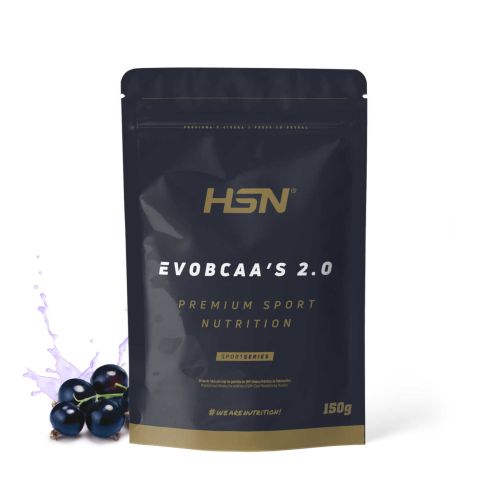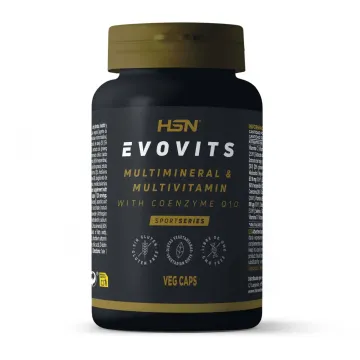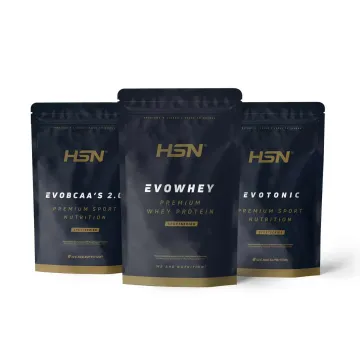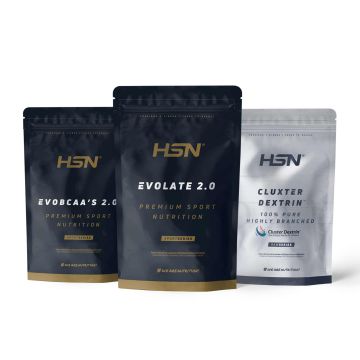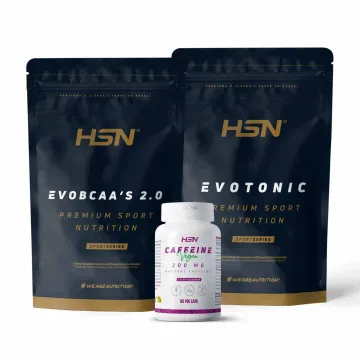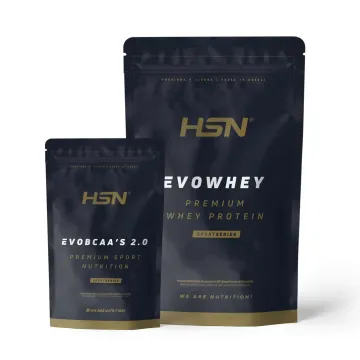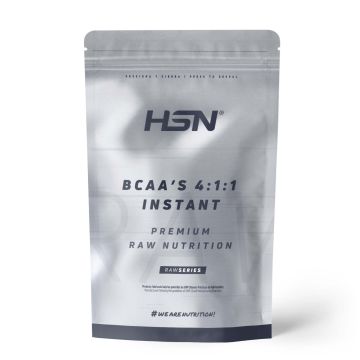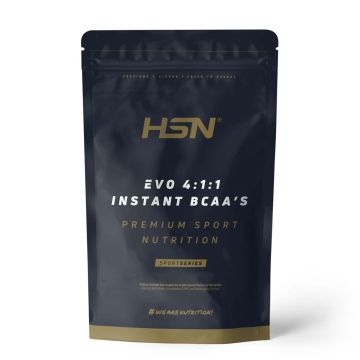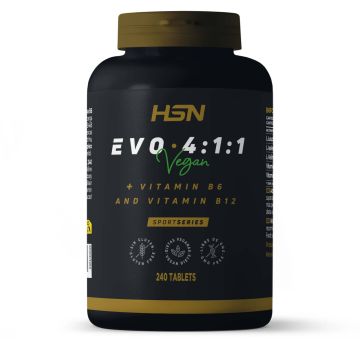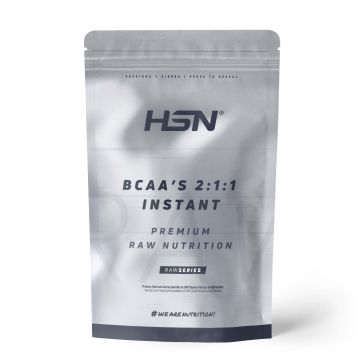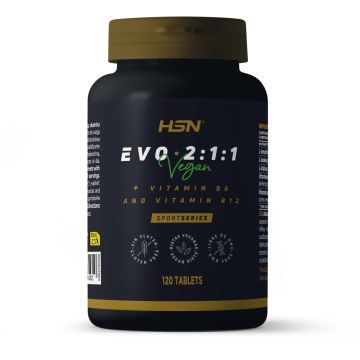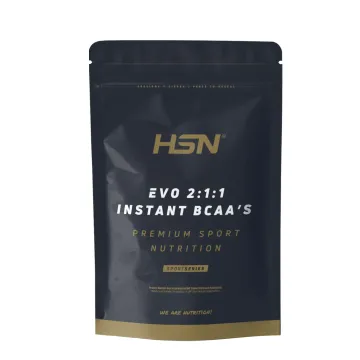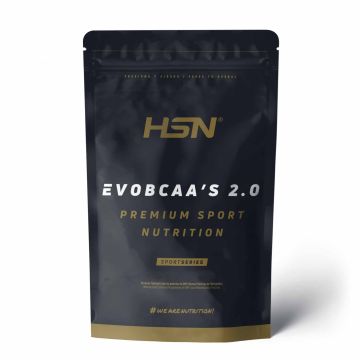- The most classic BCAA mix from HSN - Discover Evobcaa's 2.0 The best choice for you!
- Combination of branched-chain amino acids with a high density of L-Leucine. The key amino acid.
- Ratio 12 units of Leucine : 1 unit of Valine : 1 unit of Isoleucine = 12:1:1.
- With added L-Glutamine to complement the product's overall action. Up to 5.5g per daily dose.
- Kyowa® raw material - The highest quality glutamine internationally, by Kyowa Hakko Bio Co., LTD.
- All amino acids in Evobcaa's 2.0 are derived from vegetable fermentation. 100% vegan.

Evobcaa's 2.0 - 12:1:1 BCAAs + HSN Glutamine
Evobcaa's 2.0 (12:1:1 BCAAs + Glutamine) by SportSeries is HSN's most iconic product, and represents the range of options based on branched-chain amino acids. It features a blend of 3 branched amino acids and glutamine, in a 12-1-1 + 5 ratio, with sweeteners.
Branched-chain amino acids, or BCAAs, are a group of essential amino acids sharing specific chemical properties that make them a popular choice for their nutritional benefits, especially among athletes, individuals with specific amino acid requirements, and those exposed to high-energy demands, as well as older adults.
Evobcaa's 2.0 is the 'safe choice' when it comes to branched amino acids; if you're unsure which amino acids to pick to complement your training, Evobcaa's 2.0 is a guaranteed success.
Discover the ultimate combination of branched amino acids
L-Leucine + L-Isoleucine + L-Valine. The 3 branched amino acids
Essential amino acids consist of a total of 9 amino acids: Leucine, Isoleucine, Valine, Lysine, Methionine, Threonine, Tryptophan, Histidine, and Phenylalanine. You may have noticed that the first three are the BCAAs.
Indeed, BCAAs are a specific group of amino acids with their own identity as branched, meaning their R group (the variable part of the amino acid) has a carbon branch. This characteristic gives them unique properties, such as their important role in various biological processes in the body.

Sometimes, many products theoretically made 'with BCAAs' do not contain only BCAAs but are mixed with a wide range of other types of amino acids, which are ultimately cheaper and not as specific to the properties of branched-chain amino acids.
HSN's Evobcaa's 2.0 combines the 3 branched amino acids in significant proportions, transparently, without 'cutting down' or masking its content.
With added Glutamine, why is it included in Evobcaa's 2.0?
You might wonder why a BCAA-based product contains glutamine when this amino acid is neither a branched-chain amino acid nor an essential one.
The truth is that glutamine is an amino acid that becomes conditionally essential for athletes or people experiencing significant muscle wear, regardless of the cause, as it is the most abundant amino acid in muscle tissue. When this tissue is compromised, the body becomes a high consumer of glutamine.
This is why, after analysing studies and consumer feedback, we discovered that more than 80% of users combined BCAAs with Glutamine, purchasing them separately to benefit from the combined properties of the amino acids.
We decided to develop our most versatile BCAA product with a mix of branched amino acids and glutamine, so that those seeking a comprehensive and adaptable blend for various needs could find it easily. However, HSN also offers BCAA products without added glutamine, such as:

12:1:1 Ratio: Why did we choose this specific blend?
When we talk about BCAAs, we always refer to the presence of the 3 amino acids forming the branched-chain amino acids group. However, it’s important to consider that their blend must be prepared in a specific ratio. But... what's the best one?
There is no unanimous scientific answer to this, which is why HSN offers BCAA products with different proportions of Leucine:Isoleucine:Valine.
In the case of Evobcaa's 2.0, the ratio is 12:1:1, significantly favouring Leucine. This has been deliberately designed as Leucine is the most researched amino acid in isolation from the BCAA group. It has been particularly highlighted among them, earning its reputation as the star of this group of amino acids.
Kyowa® - Glutamine patent - Learn more about it
Kyowa Quality® is a registered trademark of Kyowa Hakko Bio Co., Ltd., representing a range of ultra-pure amino acids, including L-Glutamine, the amino acid in Evobcaa's 2.0 with a registered trademark. The amino acids we use are derived from vegetable fermentation processes, ensuring high quality and purity.
Kyowa® L-Glutamine is recognised for its efficacy and safety, being one of the most widely used in scientific studies worldwide.

Kyowa Hakko Bio Co., Ltd. is a Japanese leader in biotechnology and fermentation. Its mission is to contribute to global health and wellbeing by creating new values through advances in life sciences and technologies. The company has developed innovative fermentation technologies to produce amino acids, nucleotides, and other bioactive compounds. Its products, sourced from plants, are used across various industries by leading companies, such as HSN, where Kyowa® is distinguished by its quality.
Evobcaa's 2.0 Flavours: What should you know?
If you are not experienced with powdered dietary supplements, especially in RAW format, you should know that the natural taste of ultra-pure amino acids, especially leucine, is characteristically bitter. While not unpleasant for those familiar with it, it is highly noticeable.
This has led to different approaches in the market:
- On one hand, many companies have not paid much attention to developing the flavours of their BCAAs, resulting in products that still have the intensely bitter taste of the base amino acids.
- Other companies have been obsessed with completely masking the taste of BCAAs, using large amounts of additives, flavourings, and sweeteners that significantly reduce the product’s amino acid content.

At HSN, we’ve opted for our own solution: we didn’t want to launch a BCAA product with a flavour dominated by the amino acids, as that’s already available in our RAW format BCAAs. But we also refused to add excessive amounts of flavourings and sweeteners just to mask the natural taste of our amino acids.
In Evobcaa's 2.0, you’ll find a balanced product: when preparing the BCAAs, you’ll notice a slightly bitter undertone from the amino acids, but it is barely perceptible thanks to our own flavour developments, which blend ideally with the natural taste of the amino acids and have been developed without adding large quantities of additives, thus not sacrificing the nutritional content or quality of our product.
Available in fresh, subtle flavours, such as fruity options (like apple or cherry), soda-style (like cola or energy drink), or unique ones like peach iced tea with a deeper, more complex taste.
Sports uses for BCAAs: When to take them?
BCAAs are closely linked to sports use, as athletes are the main group interested in these specific amino acids. However, there is a lot of mysticism regarding when to take them.
BCAAs can be taken at any time of the day to enjoy their effects, as the body has an 'amino acid pool' where they accumulate, and their action is not immediate unless in cases of extreme need.
However, many athletes still seek the ideal time to use BCAAs. Is it better before, during, or after training?
As a standard recommendation, you can take Evobcaa's first thing in the morning to break your overnight fast, before breakfast. And take another dose during your workout. This pairs perfectly with the typical intake of protein before and/or after training.
If you don't use protein as a pre- or post-workout supplement, you can mix the total daily dose of Evobcaa's in a substantial volume of water and start drinking it before training, extending its use throughout the workout.

Combine Evobcaa's 2.0 with other products
Evobcaa's 2.0 doesn’t need to be combined with other supplements, as it is a comprehensive product containing a complete amino acid blend for its intended purpose.
That said, it has no specific contraindications of any kind, making it perfectly valid (and in fact widely used) in combination with various isolated amino acids or flavourless carbohydrates.
References
- Castell, L. M., & Newsholme, E. A. (2001). The relation between glutamine and the immunodepression observed in exercise. Amino Acids, 20(1), 49–61.
- Castell, L. M., Poortmans, J. R., & Newsholme, E. A. (1996). Does glutamine have a role in reducing infections in athletes? European Journal of Applied Physiology and Occupational Physiology, 73(5), 488–490.
- Coqueiro, A. Y., Rogero, M. M., & Tirapegui, J. (2019). Glutamine as an Anti-Fatigue Amino Acid in Sports Nutrition. Nutrients, 11(4).
- Cruzat, V., Macedo Rogero, M., Noel Keane, K., Curi, R., & Newsholme, P. (2018). Glutamine: Metabolism and Immune Function, Supplementation and Clinical Translation. Nutrients, 10(11), 1564.
- Fouré, A., & Bendahan, D. (2017). Is Branched-Chain Amino Acids Supplementation an Efficient Nutritional Strategy to Alleviate Skeletal Muscle Damage? A Systematic Review. Nutrients, 9(10), 1047.
- Gil, A. (2010). Tratado de Nutrición. Nutrición Humana en el Estado de Salud. (Coord. Martínez, E & Maldonado, J.). Madrid: Editorial Médica Panamericana.
- Hormoznejad, R., Zare Javid, A., & Mansoori, A. (2019). Effect of BCAA supplementation on central fatigue, energy metabolism substrate and muscle damage to the exercise: a systematic review with meta-analysis. Sport Sciences for Health, 15(2), 265–279.
- Jackman, S. R., Witard, O. C., Philp, A., Wallis, G. A., Baar, K., & Tipton, K. D. (2017). Branched-Chain Amino Acid Ingestion Stimulates Muscle Myofibrillar Protein Synthesis following Resistance Exercise in Humans. Frontiers in Physiology , Vol. 8, p. 390.
 Before
Before After
After During
During Morning
Morning Afternoon
Afternoon Night
Night Before
Before After
After During
During Morning
Morning Afternoon
Afternoon Night
Night Before
Before After
After During
During Morning
Morning Afternoon
Afternoon Night
Night Before
Before After
After During
During Morning
Morning Afternoon
Afternoon Night
Night Before
Before After
After During
During Morning
Morning Afternoon
Afternoon Night
Night Before
Before After
After During
During Morning
Morning Afternoon
Afternoon Night
Night Before
Before After
After During
During Morning
Morning Afternoon
Afternoon Night
Night Before
Before After
After During
During Morning
Morning Afternoon
Afternoon Night
Night Before
Before After
After During
During Morning
Morning Afternoon
Afternoon Night
Night Before
Before After
After During
During Morning
Morning Afternoon
Afternoon Night
Night Before
Before After
After During
During Morning
Morning Afternoon
Afternoon Night
Night Before
Before After
After During
During Morning
Morning Afternoon
Afternoon Night
Night Before
Before After
After During
During Morning
Morning Afternoon
Afternoon Night
Night Before
Before After
After During
During Morning
Morning Afternoon
Afternoon Night
Night Before
Before After
After During
During Morning
Morning Afternoon
Afternoon Night
Night Before
Before After
After During
During Morning
Morning Afternoon
Afternoon Night
Night Before
Before After
After During
During Morning
Morning Afternoon
Afternoon Night
Night Before
Before After
After During
During Morning
Morning Afternoon
Afternoon Night
Night Before
Before After
After During
During Morning
Morning Afternoon
Afternoon Night
Night Before
Before After
After During
During Morning
Morning Afternoon
Afternoon Night
Night Before
Before After
After During
During Morning
Morning Afternoon
Afternoon Night
Night Before
Before After
After During
During Morning
Morning Afternoon
Afternoon Night
Night Before
Before After
After During
During Morning
Morning Afternoon
Afternoon Night
Night Before
Before After
After During
During Morning
Morning Afternoon
Afternoon Night
Night Before
Before After
After During
During Morning
Morning Afternoon
Afternoon Night
Night Before
Before After
After During
During Morning
Morning Afternoon
Afternoon Night
Night Before
Before After
After During
During Morning
Morning Afternoon
Afternoon Night
Night Before
Before After
After During
During Morning
Morning Afternoon
Afternoon Night
Night Before
Before After
After During
During Morning
Morning Afternoon
Afternoon Night
Night Before
Before After
After During
During Morning
Morning Afternoon
Afternoon Night
Night Before
Before After
After During
During Morning
Morning Afternoon
Afternoon Night
Night Before
Before After
After During
During Morning
Morning Afternoon
Afternoon Night
Night Before
Before After
After During
During Morning
Morning Afternoon
Afternoon Night
Night







